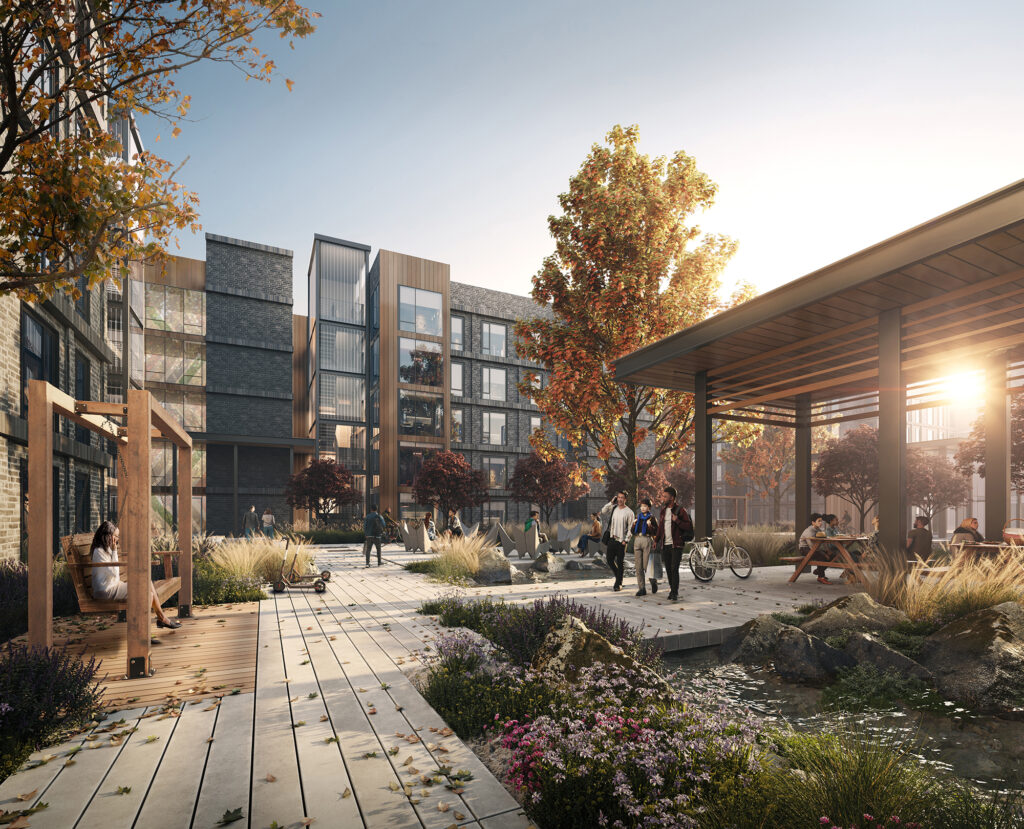
KTGY’s Marissa Kasdan expands on how holistic design can contribute to students’ overall well-being.
In the past few years, student housing design has evolved significantly, going beyond traditional functional spaces and supporting all aspects of students’ lives. Both designers and developers have become more aware of the rising need for wellness features, so their focus has shifted toward creating more spaces with natural light, outdoor areas, biophilic elements and collaborative areas.
As poor mental health is still a pressing matter for young adults, student housing operators and designers have brought online communities that put both mental and physical performance first, fostering an environment where students can interact and work together, while also having alone time. Thrive Hall, KTGY‘s student housing concept, addresses the younger generation’s mental health by incorporating a range of wellness features into design.
In the below interview with Multi-Housing News, Marissa Kasdan, the firm’s director of research and development, talks about how much students’ needs have changed lately and reveals how thoughtful design can make a difference when it comes to their overall well-being.
In the past decade, students have become more intentional about their living spaces. What are some of the latest trends shaping student housing design?
Kasdan: Everyone wants autonomy over their living environment. Individualized sleeping spaces and localized common spaces let students take a tailored approach to studying, exercising, relaxing, and sleeping. With a rising number of young people actively managing personal mental health challenges, the need to adapt one’s living space to accommodate unique health and wellness efforts has also grown.
Students are taking a more proactive approach to their personal wellness and a consideration for how design can encourage students to connect with each other, build social bonds, spend less time alone in their rooms, and adopt healthy habits, helps create an environment where students can thrive.
How have students’ housing preferences changed?
Kasdan: For a while, we saw students’ preferences lean toward larger units and more luxurious resort-style amenities. Fancy features appeal to incoming freshmen, but the reality of rising tuition and housing costs pushes students to reexamine their priorities. In 2023, total student loan debt in the U.S. topped $1.77 trillion. The overwhelming burden of student loan debt can be, in part, addressed by how we choose to design campus life.
Can thoughtful design really contribute to students’ mental well-being? What specific features does KTGY integrate into its projects to support their mental health?
Kasdan: Recently, we have been doing more research about what design features could better support the mental health of student residents. We realize that the current design strategies for student housing often inadvertently encourage students to spend significant time alone. Units typically allow students to eat, sleep, and study without ever leaving their private space.
By making private units and sleeping spaces smaller and shifting more space to lounge areas shared between a manageable group of 30 or 40 students, social connections are encouraged, and students build bonds with those around them. Smaller sleeping spaces mean that study areas are relocated to shared zones, designed to support a variety of study styles. This helps to create a separation between the relaxation of sleeping spaces and the focus of study areas, increasing the productivity of both.
Designing spaces that encourage rest and an active lifestyle at the same time can be a challenge. How can designers strike a balance between the two?
Kasdan: Combining a balance of actively and passively programmed amenity spaces can help students achieve both an active lifestyle as well as relaxation. For student housing, that might mean outdoor seating areas framed with native plantings adjacent to running paths and open lawn areas. Simple climbing structures and outdoor games are easy and accessible ways to integrate exercise, relaxation, and social time while getting students out of their rooms.
Can you expand on why it’s important today for student housing communities to include sustainability features and biophilic design?
Kasdan: Sustainability features are becoming less and less optional considering the long-term effects on our environment. Biophilic design makes it easier for students to form a positive emotional connection to their living environment and is often more sustainable than alternatives.
Outdoor space is critical to anyone’s mental health, but especially that of young people. Purposeful outdoor space gets students out of their dorms, making it fun and easy to spend time outside their peers. These considerations are important for both the health of residents and the future of our environment.
KTGY has a dedicated concept, Thrive Hall, that addresses students’ wellness and mental health needs through several vectors. How are those objectives translated into tangible design elements?
Kasdan: The seven design objectives used in KTGY’s R+D concept, Thrive Hall, include: creating community, reinforcing community, connection to nature, quality rest, intentional study spaces, active lifestyle, and mental health support. To create community, we organized the units into pods of 30 students and reinforced their connection through shared lounge spaces. Intentional study spaces were relocated from within private rooms into shared areas throughout each pod.
Separation of work from sleep helps to improve the effectiveness of both, as the negative association with school stress impacts one’s ability to sleep. Sliding walls incorporated into shared sleeping rooms form a visual and auditory buffer, solving for roommates with incompatible sleep schedules. The shared spaces within each pod allow for views of nature and daylight, as opposed to the typical enclosed corridor.
 Simple climbing structures and outdoor games are easy and accessible ways to integrate exercise, relaxation and social time while getting students out of their rooms.
Simple climbing structures and outdoor games are easy and accessible ways to integrate exercise, relaxation and social time while getting students out of their rooms.
 Thrive Hall also includes smaller fitness spaces located within each building, so those can be reached easier.
Thrive Hall also includes smaller fitness spaces located within each building, so those can be reached easier.
 Sliding doors add privacy for roommates with incompatible sleep schedules with a visual and auditory buffer.
Sliding doors add privacy for roommates with incompatible sleep schedules with a visual and auditory buffer.
The community is divided into a series of smaller buildings, each with its own fitness area, making daily activities more accessible to residents. The series of buildings on the site are woven together by a series of landscaped courtyard spaces, intertwined with a stream and walking path. We also understand that residential design can only do so much for students who are significantly struggling with mental health. All these ideas are intended to work in tandem with professional mental health support. For Thrive Hall, we proposed incorporating mental health support within the building, removing barriers to access and potential stigma.
Please tell us more about fostering a sense of community through housing pods.
Kasdan: Research by the British evolutionary anthropologist Robin Dunbar found that groups beyond 150 individuals led to an inability for group members to ‘function effectively in social relationships.’ Ideally, groups of 50 or fewer friends, including 15 good friends and five intimate friends, support healthy relationships. Often, student housing communities are designed to house hundreds if not thousands of residents. By creating pods of rooms and shared spaces intended to house 30 individuals, student housing can support the formation of strong friendships and connections.
Following your experience with Thrive Hall, how difficult is it to design student housing communities with mental health in mind?
Kasdan: None of the ideas being proposed in the Thrive Hall concept are costly or outrageous. Many of these ideas have yet to be realized in student housing developments because our developer clients see a risk in rethinking their current student housing strategy. We anticipate that some of the smaller, less disruptive ideas will be incorporated initially and that more significant changes may take longer to come to market.
Looking ahead, how does KTGY envision the future of student housing design and what role do concepts like Thrive Hall play in shaping the industry’s direction?
Kasdan: Student housing design is always changing. A couple of decades ago, we saw a shift from dorm-style units with shared bathrooms down the hall to apartment-style units with multiple bedrooms and bathrooms in each unit.
The ideas proposed in the Thrive Hall concept come out of our research into the needs of the current generation and how design can best meet those needs. As the next generation grows into adulthood, their unique wants and challenges inform what student housing looks like for their generation. KTGY’s R+D Studio is focused entirely on efforts such as the Thrive Hall concept to understand how creative design can respond to societal changes and shape the future of residential architecture.

